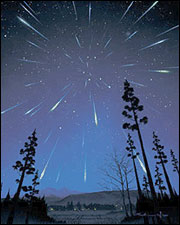Leonids Alert

In 2016 peak viewing occurs on Nov. 16 and the early hours of Nov. 17
 Related LinksExternal Links
Shooting stars aren't really stars at all, but meteoroids. Meteoroids become meteors when they enter Earth's atmosphere. If a meteor makes it to Earth without burning up entirely, it changes names once again to become a meteorite. |
What's It All About?
The Leonid meteor shower is a barrage of shooting stars that appears every year on or about Nov. 17. The meteor shower is produced when the Earth passes close to the debris trail of a passing comet, and tiny particles of dusty debris burn up in Earth's atmosphere. The meteors enter the atmosphere at about 158,000 mph, frequently leaving glowing trails for seconds or even minutes after they are vaporized.
In an average Leonid meteor shower, one might expect to see about 15 to 20 meteors per hour. In peak years, like 1966 and 1999, observers have documented seeing anywhere from 5,000 to 150,000 meteors per hour.
So called because they appear to radiate from the constellation Leo, Leonids have been reported as far back as A.D. 902, when Chinese astronomers reported that "stars fell like rain" and Egyptians declared it "the year of the stars."
Mystery Solved
It wasn't until 1866, however, that two astronomers, Horace Tuttle in the United States and Ernst Tempel in France, independently observed a dim comet, calculated its orbit, and secured a place in the annals of astronomy. Now referred to as comet Tempel-Tuttle, the orbiting body they discovered is the source of the Leonid meteor shower that has fascinated mankind for at least 1,000 years.
Are Leonids Dangerous?
While most Leonid meteors are no larger than grains of sand, some may be as large as a meter in diameter. Most Leonids will burn up in the upper atmosphere, posing no danger to humans on Earth.
—by Ann-Marie Imbornoni







